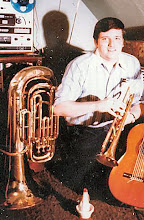

Side One
1. Bourbon Street Parade
2. I Want To Be Happy
3. Farewell Blues
4. I'm A Ding Dong Daddy From Dumas
5. How Many Hearts Have You Broken?
6. Near You
Side Two
1. Big Boy Blue
2. Woodchopper's Ball
3. Tail Gate Ramble
4. Basin Street Blues
5. I'll Be Glad When You're Dead You Rascal You
6. I'm Saving Tonight For You
One of the rarest Pete Fountain albums.
Liner Notes:
The New Orleans of today is a very much more sedate town than the New Orleans of the 1920's when that great southern city was probably the widest of the wide open cities of a bubbling nation. But even now, as you walk up and down the streets of New Orleans, you feel a special excitement. It's in the air, like oxygen. At night, particularly, the charge of the New Orleans air is electrifying.
Feel your heart. It's beating to the tempo of dixie-land jazz! They say that if you allow your imagination a little play while you're walking along a New Orleans street on a lonely night, you will hear the legendary rhythms of the Original Dixieland Jazz Band echoing through every avenue and side street of the city.
Great Jazz Names
That little five-man group was one of the real pioneers of dixieland jazz. And the names of the men who played in the group are never-to-be forgotten names with musicians of the past and the present. (Dominique, "Nick" La Rocca blew the cornet, Henry Ragas played piano, Larry Shields, clarinet, Eddie Edwards, Trombone, and Tony Sharbaro, drums.) This quintet probably did more than any other band to establish and popularize the dixieland tempo that hundreds of millions have thrilled to and danced to over the years. They played the true New Orleans jazz in their day as Tony Almerico and his Dixieland Jamboree Allstars play it today - unchanged and unspoiled.
Fabulous Is The Word
Tony Almerico is one of New Orleans' fabulous characters. He has successfully resisted every offer to showcase his band around the country. Without ever leaving New Orleans he has won far flung fame and is credited with having done more than any present day New Orleans native in reviving dixieland jazz.
A revival it was, too, for Almerico formed his dixieland band at a time when even the birthplace of jazz was "going pop". In 1948, a few New Orleans' jazzmen noted that, with few exceptions, the local bands "were playing pop stuff" Dixieland jazz was being played on request - that is, at the request of the tourist trade. Out of this picture the New Orleans Jazz Club was organized.
The club's aim was to help perpetuate public interest in dixieland jazz. The club got together with Almerico and put on Sunday afternoon jazz concerts in New Orleans' Parisian Room, 116 Royal Street. The concerts became an immediate success.
King Jazz Reigns Again
It wasn't long before Dixieland jazz once again became king in the home of jazz. Today, attending the jazz session at the Parisian Room is the big thing of a Sunday afternoon. In 1955, the mayor of New Orleans, his honor deLesseps Morrison, awarded Almerico the city's Certificate of Merit for restoring dixieland jazz to its own home town. And Almerico's Allstar Band was the first dixieland jazz band ever to appear as guest orchestra at the Summer Pops Concerts at the New Orleans Municipal Auditorum.
For the record, the Dixieland Jamboree Allstars were organized on October 3, 1948, with:
Roy Zimmerman (piano)
Joe Loyacano (bass)
Frank Frederico (guitar)
Tony Almerico (trumpet)
Johnny Castaing (drums)
Pete Fountain (clarinet)
Jack Delaney (trombone)
Sam Dekemel (bugle)
DeKemel is known in music circles as "Sam, the Bugle Man". He blows an old regulation Army bugle and out of it come some of the wildest riffs ever. He started using the bugle to attract customers to his Waffle Wagon thirty five years ago!
One thing's certain: the jazz you'll hear when Tony Almerico leads his men at a Parisian Room jazz session is the real thing - unchanged, unspoiled - The same beat, the same tempo, the same feel that characterized the Original Dixieland Jazz Band and The Memphis Five, and Razz's Band before them.
Notes on Dixieland Jazz:
As everybody knows, it started in New Orleans. The earliest jazz groups were actually negro brass bands that played at parades, funerals, political and social functions, Musicians, discarding written scores, began improvising on their own to satisfy their own imaginations. A definite beat, or form, evolved and this became the root of dixieland jazz. Several bands sprung into popularity: Charles, "Buddy" Bolden's Ragtime Band was a big name in the early nineties. Others followed, each one featuring the big dixieland beat: Willie "Bunk" Johnson, Joseph "King" Oliver, Freddie Keppard's Original Creole Band.
Then came Razz's Bard, the Original Dixieland Jazz Band, and the Memphis Five. Singers and great musicians were spawned during the years when dixieland was coming of age: the famed Ferdinand Morton was one of the greatest. A singer, pianist, arranger and composer of jazz, he was the best all-around musician produced in this New Orleans jazz period. Gertrude, "Ma" Rainey, Bessie Smith and Bertha, "Chippie" Hill topped the list of female singers. Clarinetists: Johnny Dodds, "Big Eye" Louis Nelson, George Lewis, Jimmy Noone, Lorenzo Tio, Jr., Lawrence Duke, Alphonse Picou and Sidney Bechet. (In 1917, another clarinetist started his own band and went on to highest attainments - Ted Lewis). Trombonists: Edward "Kid" Ory, Jim Robinson and Vonore Dutrey. Banjoist: Johnny St. Cyr (guitar and banjo). Pianists: "Jelly Roll" Morton, Fate Marable and Lillian Hardin (who became Mrs. Louis Armstrong).


No comments:
Post a Comment